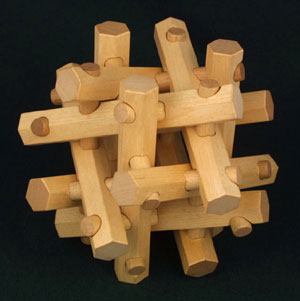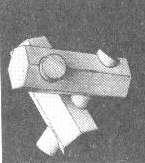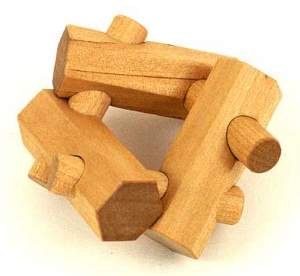
Refer back once again to the ubiquitous cluster of 12 triangular sticks in Fig. 93. For the sake of variety, reduce them from triangular to hexagonal cross-section. They will still rest flat against each other. To hold them together, drill five holes in each stick and pin them together with 12 dowels (Fig. 128).
Editor's Note: Stewart named this puzzle Locked Nest.
Fig. 128
Assembling this cluster of 12 hexagonal sticks and 12 dowels might be considered a puzzle of sorts - easy if an illustration is provided but perhaps not so easy otherwise. To make it into a more interesting puzzle, join some of the sticks and dowels to make elbow-shaped pieces (Fig. 129). The more elbows made, the harder the puzzle. With five elbows it is hard. With six elbows it is very hard. With seven, it is impossible.
Fig. 129
Hexagonal sticks are easily made by first ripping planed boards into sticks of rhombic cross-section with the saw tilted 30 degrees and then making two more cuts. All of the holes are spaced equally apart, are at the same 70½-degree angle to the axis of the stick, and are arranged in helical progression. Thus, a simple drilling set-up can be used that positions the stick using the previously drilled hole, with the stick being rotated 120 degrees in the same direction each time. The spacing of the holes can be determined by trial and error to achieve a snug fit. If they are too close together, the puzzle cannot be assembled. Spacing them farther apart simply makes a more open arrangement. With an open arrangement on a large scale, what a delightful and attractive climbing apparatus could be made for a children's playground.
This lattice structure repeats itself indefinitely in all directions, so one can make larger assemblies with more and longer sticks and dowels. From among the infinite variety of such constructions, one example is shown in Fig. 130a. It is basically two clusters joined together along their threefold axes.
Fig. 130a
Another fascinating feature of this construction is that sub-units are also possible using fewer and shorter sticks and dowels. From among the many possibilities, one example is shown in Fig. 130b. It uses four sticks and four dowels, and each stick has three holes. As an assembly puzzle it would be rather too easy if given the illustration of the solution. However, this is easily corrected by joining one stick-dowel pair to make an elbow piece and another pair to make a cross piece. This construction might also be used to make a novel collapsible stand for a tabletop.
Fig. 130b
Yet another intriguing aspect of this system is its possibilities as a play construction set. Imagine having many sticks and dowels of each size from two-hole to five-hole and then discovering all the possible symmetrical constructions starting with the smallest and building upward. A few of these are shown in Fig. 131. What a marvelous plaything this might make for some curious youngster.


Fig. 131
By making the arrangement of the holes alternate rather than helical, one obtains a different sort of lattice structure, which likewise can be extended indefinitely in all directions. Constructions made with it can have an axis of symmetry but not isometric symmetry. The version shown in Fig. 132 uses six sticks and six dowels, with each stick having three holes. It has a threefold axis of symmetry. If five stick-dowel pairs are joined together to make elbow pieces, it is a surprisingly difficult assembly puzzle with two solutions. Rather than show how the pieces are formed, we let the curious tinker enjoy the task of rediscovering them. Minor variations are possible, but there is no way to avoid having two pieces identical. A version of this puzzle was once produced under the name of Cuckoo Nest. By the way, note the functional similarities of this puzzle to the Pin-Hole Puzzle in Chapter 6.
Fig. 132
If the Cuckoo Nest Puzzle is regarded as having two layers, one way of expanding it is to add a third layer of three more sticks and three more dowels. One such version is shown in Figs. 133a and 133b. It likewise has a threefold axis of symmetry. It has only one solution and is more difficult than the Cuckoo Nest Puzzle, the Locked Nest Puzzle or its variations. Other even more complicated versions are possible with additional layers.
Editor's Note: Stewart named this puzzle Nine Bars.
Fig. 133a
Fig. 133b
Never underestimate the amazing ways that geometrical constructions can be made to fit together in space. Just when we think we have exhausted the possible hole arrangements for symmetrical hexagonal stick assemblies, yet another one is discovered. Note the arrangement of the four holes in the hexagonal stick shown in Fig. 134. If the hole at the bottom is ignored, the arrangement is helical; but if the hole at the top is ignored, the arrangement is alternate. Eight such identical sticks, together with their eight corresponding dowels, can be assembled into a structure having one fourfold axis of symmetry and four twofold axes - i.e. the same as that of a square prism. Furthermore, if four stick-dowel pairs are now joined to make elbow pieces, it becomes a most perplexing assembly puzzle. The elbow pieces have two possible forms, thus providing further amusement and bafflement for the determined puzzle analyst.
Fig. 134
The basic cluster of 12 triangular sticks shown in Fig. 93, upon which most of the designs in this and the previous five chapters have been built, suggests the possibility of converting them into interlocking notched hexagonal sticks. With two trapezoidal notches in each stick, they form a neat interlocking structure of 12 identical pieces, as shown in Figs. 135a and 135b, but which is impossible to assemble. A third notch in three of the pieces allows the puzzle to be assembled.
Fig. 135a
Fig. 135b
There are three distinctly different solutions to this puzzle, which can be defined by the arrangement of the three-notch pieces. The easiest and most obvious solution is with these three odd pieces going in last in a triangular arrangement to complete the assembly. In the second solution, the three odd pieces are mutually parallel, and there is a key piece that slides in last. The third solution is more difficult. Here is a case where multiple solutions make the puzzle more interesting.
This puzzle is enhanced by using four colors for the pieces, three of each color. If the three odd pieces are the same color, the first two solutions can have different sorts of color symmetry. The second solution is especially interesting, with all like-colored pieces being mutually parallel.
This puzzle was at one time manufactured in plastic as Hectix, but unfortunately never in four colors (saving the manufacturer a penny or two). A few have been produced in wood, which is quite easy with a supply of hexagonal stock and a trapezoidal cutter. Aside from its considerable potential as a very satisfactory assembly puzzle, it would make a handsome sculpture in brass or stainless steel, or perhaps even cast in concrete on a massive scale. (Reference: US Patent 3,721,448 to Coffin, 1973.)
The cluster of 12 notched hexagonal sticks leads by analogy to a cluster of 12 notched sticks having rhombic cross-section. They might also be regarded as augmented triangular sticks, especially since they are most easily fabricated by gluing triangular stick segments together. One possible version of such a puzzle is illustrated in Fig. 136, which uses three types of pieces, four of each. It has a rather unusual solution. Many other possible versions await investigation.
Fig. 136